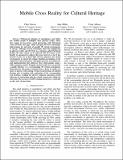Files in this item
Mobile cross reality for cultural heritage
Item metadata
| dc.contributor.author | Davies, Christopher John | |
| dc.contributor.author | Miller, Alan Henry David | |
| dc.contributor.author | Allison, Colin | |
| dc.date.accessioned | 2013-11-13T10:01:04Z | |
| dc.date.available | 2013-11-13T10:01:04Z | |
| dc.date.issued | 2013-10 | |
| dc.identifier | 75969621 | |
| dc.identifier | 0c1aa9fb-e2bd-4257-bf7b-2f7774d0e44d | |
| dc.identifier | 84896747211 | |
| dc.identifier.citation | Davies , C J , Miller , A H D & Allison , C 2013 , Mobile cross reality for cultural heritage . in Digital Heritage International Congress (DigitalHeritage), 2013 . vol. 1 , IEEE , pp. 331 - 338 , Digital Heritage International Congress 2013 , Marseille , France , 28/10/13 . https://doi.org/10.1109/DigitalHeritage.2013.6743757 | en |
| dc.identifier.citation | conference | en |
| dc.identifier.isbn | 9781479931682 | |
| dc.identifier.other | ORCID: /0000-0003-1209-9063/work/40546684 | |
| dc.identifier.uri | https://hdl.handle.net/10023/4190 | |
| dc.description.abstract | Widespread adoption of smartphones and tablets has enabled people to multiplex their physical reality, where they engage in face-to-face social interaction, with Web-based social networks and apps, whilst emerging 3D Web technologies hold promise for networks of parallel 3D virtual environments to emerge. Although current technologies allow this multiplexing of physical reality and 2D Web, in a situation called PolySocial Reality, the same cannot yet be achieved with 3D content. Cross Reality was proposed to address this issue; however so far it has focused on the use of fixed links between physical and virtual environments in closed lab settings, limiting investigation of the explorative and social aspects. This paper presents an architecture and implementation that addresses these shortcomings using a tablet computer and the Pangolin virtual world viewer to provide a mobile interface to a corresponding 3D virtual environment. Motivation for this project stemmed from a desire to enable students to interact with existing virtual reconstructions of cultural heritage sites in tandem with exploration of the corresponding real locations, avoiding the adverse temporal separation caused otherwise by interacting with the virtual content only within the classroom. The accuracy of GPS tracking emerged as a constraint on this style of interaction. | |
| dc.format.extent | 8 | |
| dc.format.extent | 408371 | |
| dc.language.iso | eng | |
| dc.publisher | IEEE | |
| dc.relation.ispartof | Digital Heritage International Congress (DigitalHeritage), 2013 | en |
| dc.subject | QA76 Computer software | en |
| dc.subject.lcc | QA76 | en |
| dc.title | Mobile cross reality for cultural heritage | en |
| dc.type | Conference item | en |
| dc.contributor.institution | University of St Andrews. School of Computer Science | en |
| dc.contributor.institution | University of St Andrews. Centre for Ancient Environmental Studies | en |
| dc.identifier.doi | 10.1109/DigitalHeritage.2013.6743757 | |
| dc.identifier.url | http://www.digitalheritage2013.org/ | en |
| dc.identifier.url | http://ieeexplore.ieee.org/xpl/tocresult.jsp?isnumber=6743693 | en |
This item appears in the following Collection(s)
Items in the St Andrews Research Repository are protected by copyright, with all rights reserved, unless otherwise indicated.

